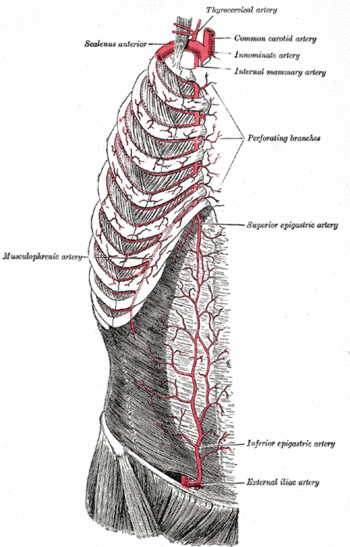Paracentesis: Difference between revisions
Jump to navigation
Jump to search

imported>Robert Badgett |
imported>Caesar Schinas m (Bot: Update image code) |
||
| Line 3: | Line 3: | ||
==Procedure== | ==Procedure== | ||
{{Image|Gray-image522.gif|right|350px|The location of the inferior epigastric artery within the sheath of the rectus muscle.}} | |||
If a lower quadrant is used, inserting the needle lateral to the rectus muscle will avoid the inferior hypogastric artery. | If a lower quadrant is used, inserting the needle lateral to the rectus muscle will avoid the inferior hypogastric artery. | ||
Revision as of 08:41, 8 June 2009
A paracentesis is a medical "procedure in which fluid is withdrawn from a body cavity via a trocar and cannula, needle, or other hollow instrument."[1][2][3] A paracentesis usually refers to removing ascites.
Procedure
If a lower quadrant is used, inserting the needle lateral to the rectus muscle will avoid the inferior hypogastric artery.
Routine ultrasonography can increase success rates according to a randomized controlled trial.[4]
If more than 5 liters of acites are removed, consider giving 6.25 g of albumin for each liter over 5 liters.[5]
Interpretation of results
Cell count
- Polymorphonuclear cells count of 250/mm3 or more suggests spontaneous bacterial peritonitis
Albumin
- A serum-ascites albumin gradient (SAAG) of less than 1.1 g/dL lowers the probability of portal hypertension.[2]
Protein
- Protein levels less than 1 g/dL have a high risk of spontaneous bacterial peritonitis during hospitalizations.
Ph
- "An ascitic fluid pH of lower than 7.35 (likelihood ratio=9.0) and a blood–ascitic fluid pH gradient of 0.10 or greater (likelihood ratio=11.3) were the most accurate thresholds for diagnosing spontaneous bacterial peritonitis" according to a systematic review by the Rational Clinical Examination.[2]
Cultures
References
- ↑ Anonymous (2024), Paracentesis (English). Medical Subject Headings. U.S. National Library of Medicine.
- ↑ 2.0 2.1 2.2 Wong CL, Holroyd-Leduc J, Thorpe KE, Straus SE (March 2008). "Does this patient have bacterial peritonitis or portal hypertension? How do I perform a paracentesis and analyze the results?". JAMA 299 (10): 1166–78. DOI:10.1001/jama.299.10.1166. PMID 18334692. Research Blogging.
- ↑ Thomsen TW, Shaffer RW, White B, Setnik GS (November 2006). "Videos in clinical medicine. Paracentesis". N. Engl. J. Med. 355 (19): e21. DOI:10.1056/NEJMvcm062234. PMID 17093242. Research Blogging.
- ↑ Nazeer SR, Dewbre H, Miller AH (May 2005). "Ultrasound-assisted paracentesis performed by emergency physicians vs the traditional technique: a prospective, randomized study". Am J Emerg Med 23 (3): 363–7. PMID 15915415. [e]
- ↑ Ginès P, Titó L, Arroyo V, et al (June 1988). "Randomized comparative study of therapeutic paracentesis with and without intravenous albumin in cirrhosis". Gastroenterology 94 (6): 1493–502. PMID 3360270. [e]
